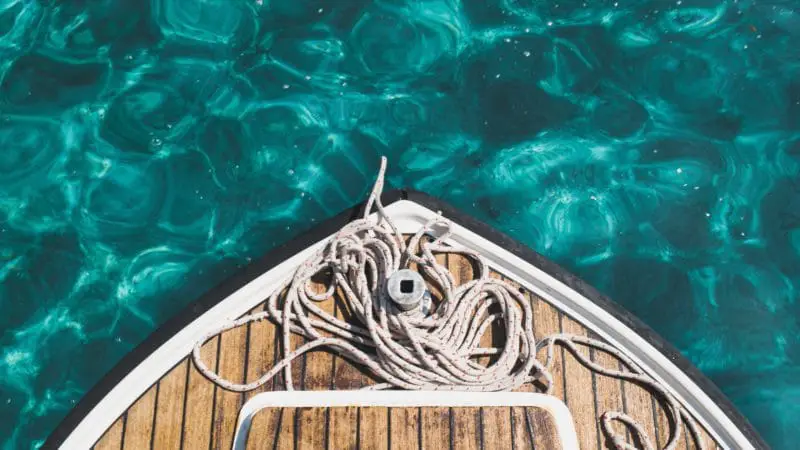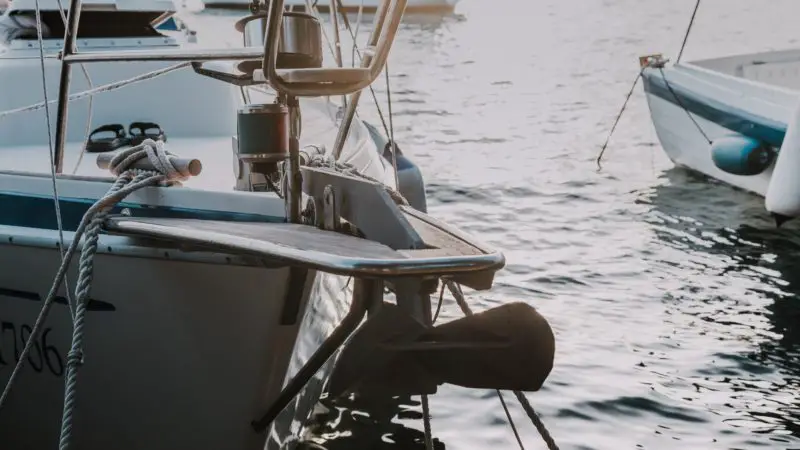GUIDE: How to make a suitable mooring line?
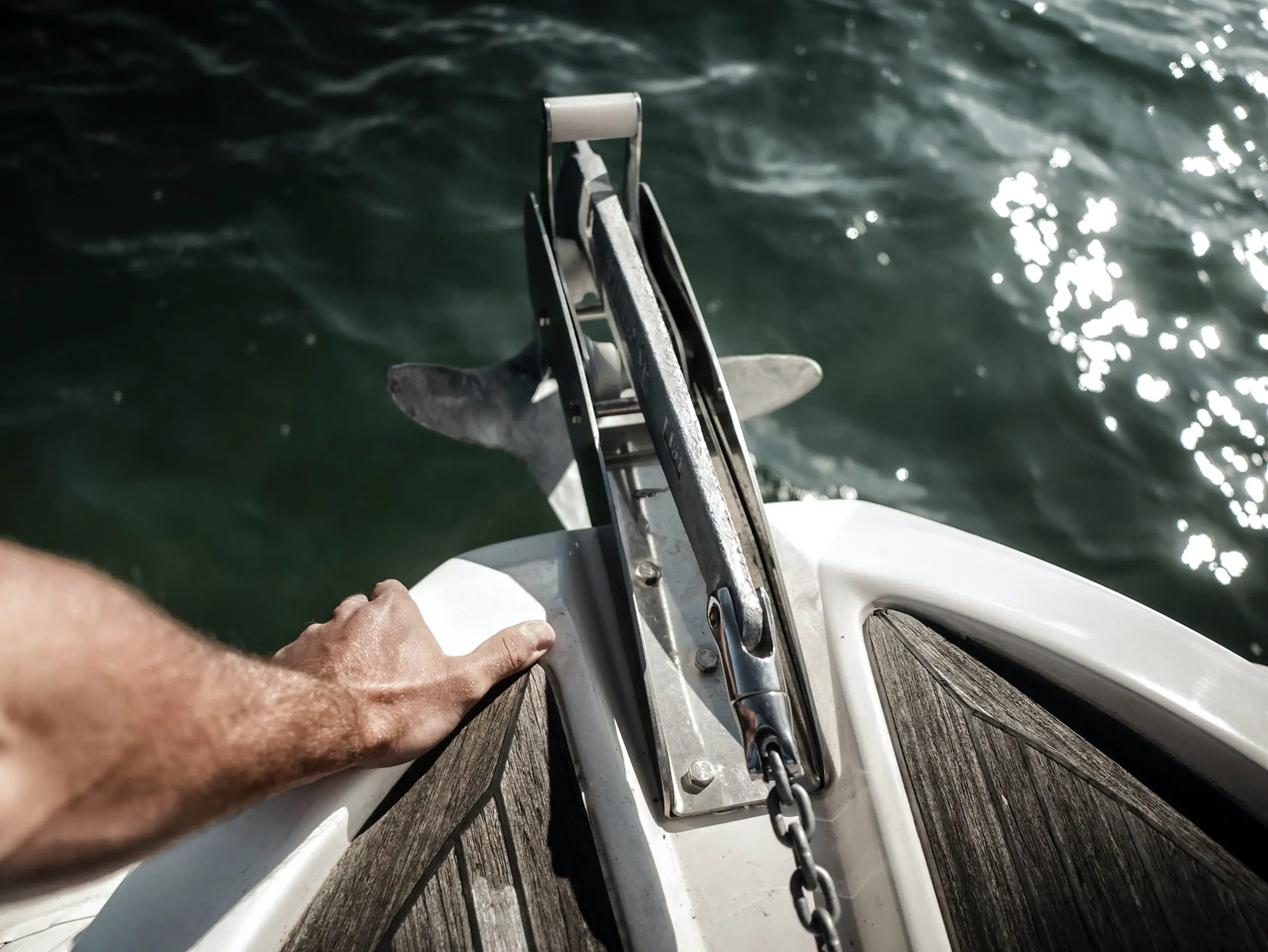
To sleep well on a boat at anchor, you need to have confidence in your anchor! Many boaters fear that it will unhook and that their boat will end up on the rocks. Many factors will influence your anchorage such as the current, the speed and direction of the wind or the quality of the seabed. Unfortunately, you cannot change these natural factors. However, you can ensure that you have complete, high-quality mooring gear that is suitable for your boat. In this article, we explain how to make a proper mooring line.
Contents of the page
How to make a mooring line: the complete composition
To get started, you need to know all the necessary elements. The composition of a complete mooring line is: An anchor, a swivel, a chain, a shackle, a thimble and a cable.
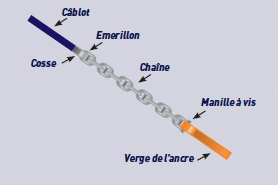
Then, to raise and lower your anchor, you will need a davit and a windlass (except for small anchors such as dinghy anchors).
Finally, to protect your windlass, it is essential to have an anchor damper.
In addition to this list of essentials, your mooring line can be completed with a bow protection, a chain marker, a mooring buoy, an anchor release, or even a chain distributor. Although optional, these elements will make your life easier so that anchoring remains a pleasure!
How to make a mooring line that respects the regulations
Anchor lines are subject to simple regulations: 'All boats are required to have on board a appropriate mooring line '. There is however an exception to this legislation for boats which cannot embark more than 5 adults. Then the captain of the vessel can take the responsibility of not having a mooring system on board.
How to set up an appropriate mooring line for your boat?
To function properly, you need set up a suitable mooring line to your boat. Indeed, it is necessary that all the elements are adapted to each other. You will need to have:
- an anchor adapted to the characteristics of your boat,
- a chain adapted to your sprocket,
- a davit adapted to your anchor,
- a shackle adapted to the weight of the anchor,
- a swivel adapted to the diameter of the chain and rope,
- etc ...
To make it easier for you, we explain how to make a complete and proper mooring line in the guide below. We have selected all the best elements and you just need to follow our explanations to choose the ones that are suitable for your boat. So your mooring line will work wonderfully!
How to choose your mooring line: our practical guide
Choose an anchor adapted to your boat
When making your mooring line, you must always start your reflection with the anchor. From this will derive the diameter of chain and cable required. The chain and the cable will in turn influence the diameter of the shackle, swivel, thimble, gypsy (and therefore windlass), chain markers, etc.
The weight of the anchor required for the boat is calculated by referring to the table below.
| Maximum length Of the boat | displacement Of the boat | Minimum weight anchor | Ø shackle | Ø chain | Ø cable |
|---|---|---|---|---|---|
| Canoe or optimist | - | 2 kg or 4,4 lbs | 8 mm | 6 mm | 6 mm |
| Light, pneumatic dinghy, sport catamaran up to 4 m | 300 kg | 3,5 kg or 7,7 lbs | 8 mm | 6 mm | 6 - 8 mm |
| Boat up to 5,50 m | 800 kg | 6 kg or 13 lbs | 8 mm | 6 mm | 10 mm |
| 6,50m | 1000 kg | 8 kg or 17 lbs | 8 mm | 6 - 7 mm | 10 mm |
| 7,50m | 2000 kg | 10 kg or 22 lbs | 10 mm | 8 mm | 14 mm |
| 9m | 3000 kg | 12 kg or 26 lbs | 10 mm | 8 mm | 14 mm |
| 10,50m | 4500 kg | 14 kg or 31 lbs | 10 mm | 8 mm | 14 mm |
| 12,50m | 8000 kg | 16 kg or 35 lbs | 12 mm | 10 mm | 18 mm |
| 16m | 12000 kg | 20 kg or 44 lbs | 12 mm | 10 mm | 18 mm |
| 18m | 16000 kg | 24 kg or 50 lbs | 16 mm | 12 mm | 22 mm |
| 20m | 20000 kg | 34 kg or 75 lbs | 16 mm | 14 mm | 24 mm |
| 25m | 30000 kg | 40 kg or 88 lbs | 16 mm | 14 mm | 24 mm |
| +25m | 30000 + kg | 60 kg or 140 lbs | 18 mm | 16 mm | 28 mm |
Once the weight of the anchor has been defined, the type of anchor must be chosen according to the sea floor and its holding capacity. The different types of anchor are:
- The flat anchor:
It is the type of anchor most used with many models such as the Danforth, Fortress or Britany anchor. It is perfect for sandy or muddy soils but does not work well on hard or seaweed covered bottoms. It has the advantage of being foldable.
- The plow anchor:
It adapts to all backgrounds without having fantastic results in any of them. This versatility makes it the favorite anchor for boaters. You have the choice between an articulated rod like the CQR anchor or a fixed rod like the Kobra, Delta, DTX or DC Anchor.
- The concave shovel anchor (or weighted spoon)
It is certainly the most efficient anchor on any type of ground. But it is also the most expensive… We can cite the Rocna model.
See Rocna anchors from 4 to 33 kg
- The mushroom anchor:
It only works in mud or fine sand. It is therefore very rarely used ...
- The grapple anchor:
It is the anchor of tenders or small fishing boats. It is the best solution for rocks or coral. However, it hangs easily at the bottom ...
- The Bruce anchor:
She is a mix between a spoon and legs. It is a hybrid anchor functioning as a ploughshare and grapple anchor. We can cite the famous Trefoil model.
See 5 and 7,5 kg Trefoil Anchors
See Trefoil anchors from 5 to 50 kg
See Trefoil anchors from 2 to 80 kg
NB: it is strongly recommended to have a back-up anchor on board in case you lose the main anchor (in the case of an anchor that cannot be refitted, for example). Ideally, this emergency anchor should be of a different type than the main anchor. This way you are more versatile depending on the sea floor of your anchorage. Finally, the emergency anchor must be heavier than the main anchor to be used in extreme weather conditions.
Certain types of anchors are easier to store than others. For example, plow, Bruce or concave shovel anchors are very bulky and often remain on the davit. While flat anchors can fold up and be stored in your anchor locker.
It is for these reasons that we advise you to choose three anchors for your boat:
- A Bruce anchor, plow or concave shovel as the main anchor. It will be powered by a windlass and will stay on deck. We prefer Rocna models because they are the most efficient. But if your budget doesn't allow it, a Trefoil, Delta or CQR anchor will do just fine.
- A flat anchor as a back-up anchor because it can be stored easily. We prefer the Fortress models because they are removable. But if your budget doesn't allow it, a Britany or Danforth anchor is also suitable.
- A grapple anchor adapted to the size of your tender.
Choosing an Anchor Junction Appropriate for Your Anchor Line
The most economical way to connect the anchor to the chain is a special anchor shackle with a hexagon socket axle. Remember that you should always choose a shackle with a diameter greater than that of the chain (see table above).
NB: always check that your shackle is properly locked (you can put a cable tie in the eyelet of the axle and attach it to the body of the shackle to prevent it from unscrewing).
You can also choose a hinged anchor junction. These systems are very practical because they avoid the recurring problem of the shackle which remains hooked in the forceps.
- See articulated anchor junctions for ø 8mm chain
- See articulated anchor junctions for ø 10-12mm chain
- See articulated anchor junctions for ø 12-14mm chain
Finally, the latest innovation is the curved anchor junction. In addition to avoiding the blocking of your anchor in the davit because of the shackle, this junction takes care of turning your anchor automatically to the correct side when it enters the davit. Indeed, modern asymmetric anchors (Bruce, Delta, Trefoil or other type) have a 50% probability of mounting the davit on the wrong side.
- See curved anchor junctions for ø 6 or 8 mm chain.
- See curved anchor junctions for ø 10 or 12 mm chain.
Choose an anchor chain suitable for your boat
The chain of your anchor must be in galvanized steel (and especially not in stainless steel). Calculating the length of your mooring line is very simple. The chain must be at least 5 times the length of the boat and of sufficient diameter (see table above). If you already have a windlass on your boat, then you need to check that the diameter of your chain is compatible with the gypsy.
- See calibrated galvanized chains of ø 12 mm x 100 m
- See calibrated galvanized chains ø 10mm x 50 m
- See calibrated galvanized chains of ø 8 mm x 25 m
- See calibrated galvanized chains of ø 6 mm x 25 m
NB: If your chain is too short, you can lengthen it using riveted chain links. These links are also used to repair an old too worn link. It is therefore advisable to always have a few on board as well as a pair of rivets and rivets.
We advise you to use the riveted links below because they have breaking loads equivalent to or even greater than that of the original links. In addition, their dimensions in mm correspond exactly to those of anchor chains. Thus, you are sure to have a quality link that will not get caught on your gypsy.
- See rivet links for ø 6 mm anchor chain
- See rivet links for ø 8 mm anchor chain
- See rivet links for ø 10 mm anchor chain
- See rivet links for ø 12 mm anchor chain
Choose an anchor chain / cable junction appropriate for your mooring line
This junction is designed to connect the chain from the anchor to the rope, thus avoiding tying a knot which can cause problems. The anchor chain / cable junction consists of:
- a terminal which protects against friction and prevents wear of the cable.
- a swivel which prevents twists between the cable and the chain.
You must choose a thimble of the same diameter as your cable and take a swivel with a diameter greater than the thimble. For example if your cable has a diameter of 14mm, then take a Ø 14 mm thimble and a ø 16 mm swivel (or ø 19mm to have room).
Choose a stainless steel lug of the appropriate diameter:
- Stainless steel thimble Ø 2 mm
- Stainless steel thimble Ø 2,5 mm
- Stainless steel thimble Ø 3 mm
- Stainless steel thimble Ø 4 mm
- Stainless steel thimble Ø 5 mm
- Stainless steel thimble Ø 6 mm
- Stainless steel thimble Ø 8 mm
- Stainless steel thimble Ø 10 mm
- Stainless steel thimble Ø 12 mm
- Stainless steel thimble Ø 14 mm
- Stainless steel thimble Ø 16 mm
- Stainless steel thimble Ø 18 mm
- Stainless steel thimble Heavy version Ø 20 mm
- Stainless steel thimble Heavy version Ø 22 mm
- Stainless steel thimble Heavy version Ø 24 mm
- Stainless steel thimble Heavy version Ø 28 mm
- Stainless steel thimble Heavy version Ø 30/32 mm
- Stainless steel thimble Heavy version Ø 34/38 mm
Finally, if the diameters match, you can use the OSCULATI junction. This junction is very practical because it is all in one:
Choosing the right mooring line for your boat
Some prefer make a 100% chain mooring line for a better hold but we prefer to have a mixed line (chain / cable) so as not to weigh down the bow. The rode (also called mooring line) must be at least 5 times the length of the boat. Regarding its diameter, you can refer to the table at the top of the article. Once you know the diameter and length of the mooring line, all you have to do is choose the color!
- See the 200m spools of special 3-strand polyester mooring line:
NB: The end of your cable must always be attached to your boat with a releasable knot.
Choose a suitable mooring kit for your boat
To make your life easier, you can purchase a wetting kit. These kits contain all the elements necessary for make a complete mooring line : anchor, shackle, chain and rope. All you need to do is select the appropriate anchor type and weight for your boat. To do this, refer to the previous paragraphs.
- See 4, 6 or 8 kg grapple anchor mooring kits
- See 4.2, 6.2 or 8.8 kg Hall anchor mooring kits
- View Britany 10, 12 or 14 kg Anchor Mooring Kits
- View Trefoil 10 or 13 kg Anchor Mooring Kits
- View Delta 10kg Anchor Mooring Kits
IMPORTANT: Once you have made your anchor line for your main anchor, don't forget to do the same for your backup anchor and grapple!
Calculation of the required mooring line length
As a reminder, when anchoring, you will need to use a length of chain + rope equivalent to 5 times the depth. So for an anchorage at a depth of 15 meters, you will need at least 75m of chain and cable.
How to make a mooring line: essential accessories
Now that you know how make a mooring line, you need the appropriate accessories to handle it. The windlass is the central element. It is used to raise and lower the anchor. In addition, to protect your equipment, it is strongly recommended that you equip yourself with a davit, anchor shock absorber and bow protection.
Choose the correct davit for your anchor
The davit is an essential part of a boat. It is used to guide the mooring line while preventing the chain from rubbing on the hull. Choose a davit that adapts to the weight and type of anchor on your boat. Your best bet is to choose a davit that fits all anchors. This way, it can be used with your main anchor and your secondary anchor even if they are of different types. Below are our three favorite davits. The first is our number 1 choice because it fits all anchors, the second is an economical davit for all types of small anchors and finally the third is perfect for very large anchors.
- See the rocking davit suitable for all anchors up to 20kg
- See the cheap davit suitable for all small anchors under 7,5kg
- See the davit suitable for large Bruce or Trefoil anchors between 20 and 30 kg
Choose the right windlass for your boat
There are many windlasses on the market. You will have to choose between a manual or electric windlass, vertical or horizontal windlass, a windlass with or without a tailstock, a 12V or 24V windlass… Then, you will have to select the right parameters such as the diameter of the gypsy (6, 8 or 10 mm) and the power of the windlass (500W, 700W, 1000W, 1500W,…). All this while considering the space available on and under the deck, the size of your anchor locker, the weight and composition of your anchor line and the power of your boat's electrical system.
In short, choosing the right windlass for your boat cannot be improvised. To be sure to make the right choice, let yourself be guided by reading our article: What type of windlass should I choose for my boat?
How To Make An Anchor Damper For Your Anchor Line
Installing an anchor shock absorber is crucial to avoid damaging your windlass. The anchor damper prevents the windlass from remaining under tension and from receiving jerks from the chain when anchored. It consists of a hook that catches the chain. This hook is connected to the anchor damper which itself is connected to a mooring with splice. The mooring is then stretched over one or more cleats until the chain tension on the gypsy is removed.
- See hooks for anchor chain ø 6 to 8 mm or ø 10 to 12mm
- See the best anchor shock absorber
- See mooring lines with ø 10, 12, 14, 16, 20 or 24 mm splices
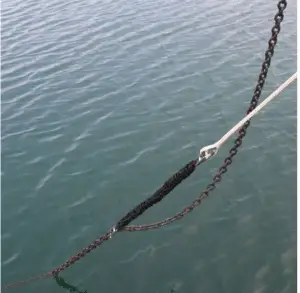
CAUTION: NEVER leave the anchor tension on the gypsy. ALWAYS attach the anchor line to a cleat even if you are not yet equipped with an anchor shock absorber.
Why equip yourself with bow protection?
When anchored, your anchor can knock against the bow of the boat. We recommend protecting this area with bow protection.
How to make a mooring line: the elements that make life easier
We consider the elements mentioned in the previous paragraphs to be essential for all boats. They are the basics to have for make a complete mooring line. However, for this article to be complete, we need to cite a few additional elements. We are of course talking about chain markers, chain distributors or even mooring buoys. They are not mandatory but they will make your life much easier.
The best way to mark the length of your anchor chain
The most economical way to mark the length of the chain elapsed is to use cable ties, but they often interfere with the operation of the sprocket.
Today there are chain markers. They are specially designed to be compatible with all windlasses. We highly recommend them to anyone who wants to avoid unnecessary problems ...
How to properly distribute the anchor chain in your anchor locker
A chain distributor is a very practical item! It distributes the chain evenly throughout the anchor locker. It thus avoids having a pile of chain which overflows and becomes tangled when reassembling the anchor.
The best buoys to protect your anchor line
When anchoring, the buoy is used to signal the position of your anchorage to other boats so that they do not damage your line. Few people use them when they could avoid many disasters ... The mooring buoy is the easiest accessory to put in place to avoid hours of annoyance with other boaters!
- See a simple, inexpensive but effective mooring buoy!
- See an inflatable mooring buoy (very practical to store it on board)
NB: whatever the buoy, be careful not to unhook the anchor because of the too short end!
However, if your budget allows it, we advise you to choose a more sophisticated mooring buoy. Indeed, no boat owner wants to go through hell with a stuck anchor… To avoid this, it is enough to equip yourself with a mooring buoy with strap. The strap attaches to the anchor diamond and when the anchor drops, the strap unwinds at the same time. If the anchor gets stuck, it can be recovered very easily by pulling the strap.
- See the best mooring buoy with strap
- See the ULTIMATE mooring buoy : with strap and lighting to be seen even at night
Many other systems exist to recover an anchor caught in the mooring lines of other boats. These systems are called anchor releasers. If you do not have a buoy with a strap, we highly recommend that you have one of these systems. It's always better than having to dive with a mask and a snorkel to get an anchor!
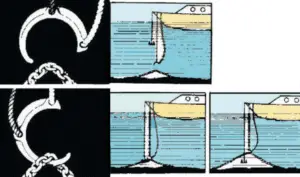
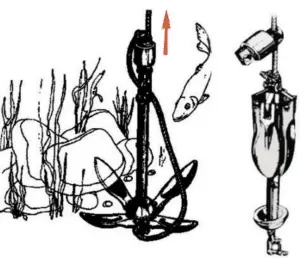
Conclusion to make a complete and appropriate mooring line
The mooring line is crucial and its manufacture should not be neglected. There are many elements that make it up and you have to choose them wisely so that they work in harmony. Otherwise, you are putting your life and that of your passengers at risk. Now that you know how make a complete and proper mooring line, do not forget to maintain it regularly !
Last tip: To reduce the cost of your mooring line, you can look for second-hand items on Amazon, Cdiscount or Ebay. From time to time there are good opportunities like cheap windlasses or anchor chains still in perfect condition.
Find out more about boat mooring lines:
What is the best windlass for my boat?
